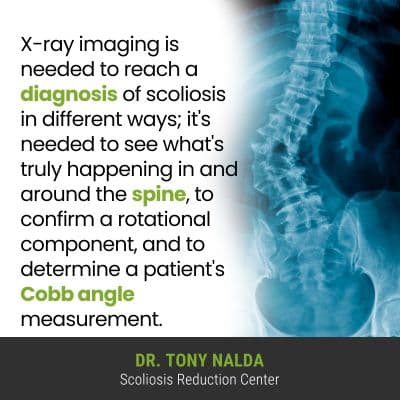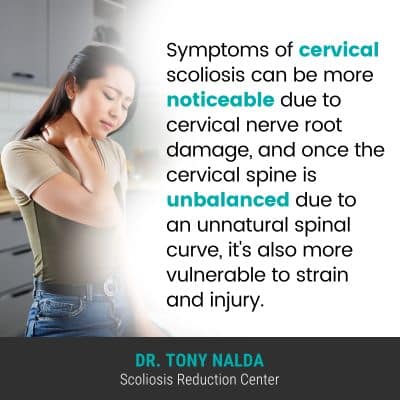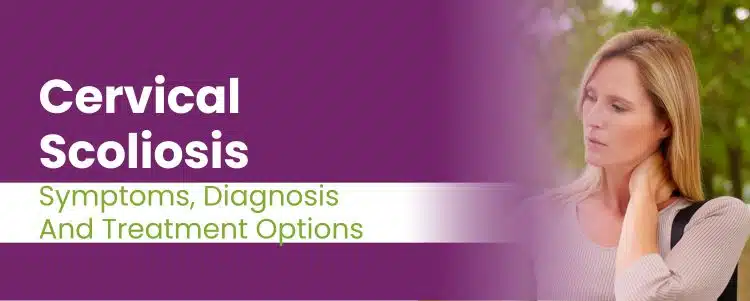Every case of scoliosis is unique, and in most cases, the area of the body located the closest to the affected spinal section is going to feel the majority of the condition’s direct effects. Maintaining a healthy curve in the cervical spine is important in a number of ways; continue reading to find out more.
Scoliosis can develop in any of the spine’s main sections, and a diagnosis of cervical scoliosis means an unnatural sideways-bending and twisting spinal curve has developed in the neck. The cervical spine has to support the weight of the head and facilitate the neck’s range of motion.
Before getting to the specifics of cervical scoliosis, let’s explore some basic anatomy of the spine for a better understanding of the different spinal sections and their roles.
Sections of the Spine
There are three main spinal sections, and each plays a role in maintaining spinal health and function.
When a spine is aligned, its vertebrae are stacked on top of one another as they should be, and this means its natural and healthy curves are in place, and the spine’s healthy curves make it stronger, more flexible, and better able to absorb and distribute mechanical stress incurred during activity.
If the spine is not aligned, it’s unbalanced, and this can cause a number of problems.
Scoliosis involves the development of an unnatural spinal curvature that bends to the side and also twists, making scoliosis a 3-dimensional condition.
The cervical spine consists of the neck; the thoracic spine includes the middle/upper back, and the lumbar spine refers to the lower back.
The lumbar spine has the unique role of having to support the weight of the spinal sections above, the trunk, and its vertebrae feel the effect of bending, twisting, and lifting motions.
The thoracic spine is the largest spinal section, and it’s the only section that attaches to the rib cage, so the thoracic spine supports the rib cage, and the rib cage supports the thoracic spine, and together, they protect the heart and lungs.
The cervical spine, like the sections below, has its own unique roles to play.
The Role of The Cervical Spine

The cervical spine connects the brain to the rest of the body, and it also has to support the weight of the head, the neck, and facilitate a wide range of motion for the neck so it can turn the head from side to side and up and down.
In some cases of cervical scoliosis, the unnatural spinal curve that affects the cervical spine is part of a larger curvature in the thoracic region, but in less-common cases, the scoliosis can develop in the cervical section alone.
Diagnosing Cervical Scoliosis
Cervical scoliosis is diagnosed through a combined physical examination that includes taking the patient’s family history and medical history, observing a patient’s posture and gait, and performing an Adam’s forward bend test.
An Adam’s test is the gold standard of screening exams that looks for indicators of scoliosis by having a patient bend forward at the hips, as if trying to touch the toes, and examining the spine in this position; in this position, the spine is highly visible, as are any related trunk asymmetries, and when combined with the use of a Scoliometer, a patient’s angle of trunk rotation (ATR) can be determined.
If an Adam’s forward bend test turns up indicators of scoliosis, this warrants the need for further testing in the form of an X-ray.
X-ray imaging is needed to reach a diagnosis of scoliosis in different ways; it’s needed to see what’s truly happening in and around the spine, to confirm a rotational component, and to determine a patient’s Cobb angle measurement.
A patient’s Cobb angle is determined by drawing lines from the tops and bottoms of the curve’s most-tilted vertebrae, and the resulting angle is expressed in degrees.
The higher a patient’s Cobb angle, the further out of alignment the spine is, and the more severe the condition.
- Mild scoliosis: Cobb angle measurement of between 10 and 25 degrees
- Moderate scoliosis: Cobb angle measurement of between 25 and 40 degrees
- Severe scoliosis: Cobb angle measurement of 40+ degrees
- Very-severe scoliosis: Cobb angle measurement of 80+ degrees
In most cases, the more severe a condition is, the more noticeable its effects are going to be.
Symptoms of Cervical Scoliosis
Symptoms of cervical scoliosis can be more noticeable due to cervical nerve root damage, and once the cervical spine is unbalanced due to an unnatural spinal curve, it’s also more vulnerable to strain and injury.
Every case is different and can cause its own symptoms, and when it comes to cervical scoliosis, common symptoms can include neck pain, shoulder pain, pain that radiates into the arms due to nerve compression, and headaches.
The larger the size of the unnatural curve in the neck, the more symptomatic it’s likely to be, and as a progressive condition, scoliosis has it in its nature to get worse over time, so even if a patient’s scoliosis is diagnosed as mild doesn’t mean that’s where it will stay; the best way to counteract the condition’s progressive nature is through proactive treatment.
Cervical Scoliosis Treatment Options

When it comes time to decide how to treat scoliosis, this is the most important decision to be made because there are different ways to address scoliosis that shape long-term spinal health and function.
There are two main ways to address scoliosis with treatment: surgically or nonsurgically.
Surgical treatment is a type of spinal fusion that involves fusing the curve’s most-tilted vertebrae into one solid bone, and then rods are commonly attached to the spine with pedicle screws to hold it in an aligned and straight position; this, however, is contrary to the spine’s movement-based design.
Here at the Scoliosis Reduction Center®, my patients benefit from a conservative proactive treatment approach that offers a nonsurgical treatment alternative and is proactive, as it’s started as close to the time of diagnosis as possible.
Conservative treatment is integrative so it can impact conditions on every level; through condition-specific chiropractic care, I can work towards adjusting the position of the curve’s most-tilted vertebrae back into alignment with the rest of the spine.
Once I have seen structural results in the form of a curvature reduction, I can shift gears to focusing on increasing core strength for optimal spinal support and stabilization, and this is worked towards through physical therapy and scoliosis-specific exercises.
Not only does increasing core muscle strength give the spine more support, it can also improve posture, and certain exercises are known to stimulate specific areas of the brain for improved body positioning and brain-body communication.
Rehabilitation can involve a series of custom-prescribed home exercises that patients can easily perform from home so they can continue to heal and stabilize their spine for long-term sustainable treatment results.
Conclusion
So cervical scoliosis is diagnosed through a combined physical examination and X-ray results.
Symptoms of cervical scoliosis will depend on the condition’s severity, but commonly includes neck pain, pain in the upper back region, nerve pain and headaches.
There are always prescription medications that can help with pain management, but the best way to minimize the effects of cervical scoliosis, including pain, is through proactive treatment that addresses the condition’s underlying structural nature.
Having a healthy curvature of the spine in the cervical region is important because it connects the brain to the rest of the body, has to support the weight of the head, and enables the neck’s range of motion.
In addition, the spine can respond to the loss of a healthy spinal curve with the addition of compensatory curves, so if the cervical spine is bent and twisted unnaturally, the spine can respond by adding another curve below the cervical section in an attempt to counteract the uneven forces of cervical scoliosis.
So the most important thing to understand about cervical scoliosis, and any type of scoliosis, is how important treating it proactively is because as a progressive condition, its nature is to get worse over time, and progression makes it more complex to treat.
If you or someone you care about is noticing a change in their neck’s position, or is experiencing symptoms of neck pain and tingling pain in the arms, this could mean the cervical spine has lost its natural and healthy curve, and treatment will be needed to restore the cervical spine’s alignment.




